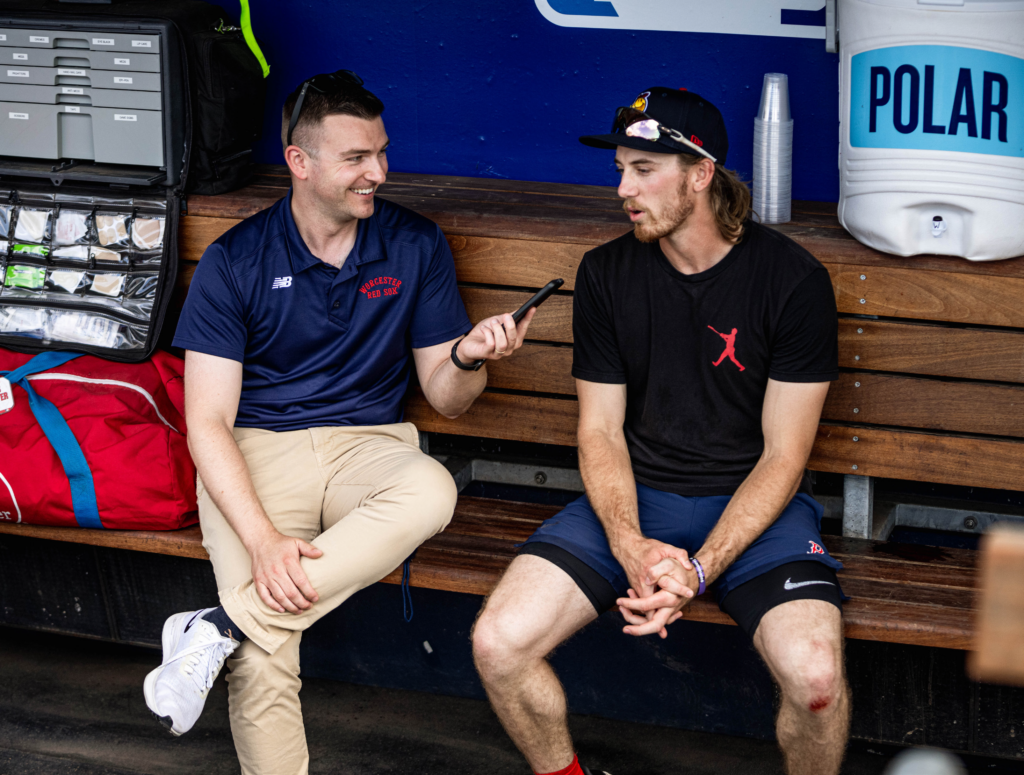
Andrew Johnson
If you’ve watched a WooSox game on television, you’ve most likely heard Jim Cain’s voice. Perhaps it is now familiar to you if you tune in often. He is now in his 6th season as a member of the radio and television crew, though his interest in broadcasting was embedded within him long before he began calling games in both Pawtucket and Worcester.
“I dabbled in play-by-play in college, but I never thought I could make a career out of it,” Jim explained. “After covering MLB Spring Training during spring break of my senior year of college, I was presented an opportunity to work for the Bradenton Marauders, the High-A affiliate of the Pittsburgh Pirates, after I graduated.”
And so he began working in Florida. After a few weeks, he was given his first opportunity to join the broadcasting team there, and he soon fell in love with the profession. His decision to pursue a career as a play-by-play broadcaster was a slight change in plans, though he always held a particular fondness for the folks calling games in the booth.

photo by Tayla Boluc
“I grew up watching Don Orsillo and Jerry Remy, and it was obvious how much fun they had on a nightly basis,” Jim reflected. “They got paid to go to Fenway Park, talk about and watch the Red Sox, which I thought was the coolest thing in the world.”
There is an aspect of the job that is quite intimate. Broadcasters are a constant voice that resonates in a dedicated fan’s kitchen or living room or bedroom. It must be a voice that is articulate, confident, and friendly. One that conveys excitement and disappointment and everything in between without being distractingly emotional. A voice that, above all, must sound pleasant to the ear.
While honing his tone and timbre, Jim quickly pivoted away from aspirations to become a sports anchor in a remote studio and grew to appreciate being close to the action and relaying his thoughts in real time. In doing so, he adjusted to a new normal where the days are long but gratifying. His schedule now, many years removed from his time in Bradenton, includes a long list of responsibilities.
“For home games, I usually get to the office around 10:30am. We have our game day meeting at 11:00am, and I usually spend the first half of my day focusing on ticket sales before shifting into broadcasting mode in the afternoon.” (Note: this schedule is for a night game; day games require a much earlier start.)
“I’ll start my prep around 3:00pm, record a segment for our TV pre-game show, go down to the clubhouse to talk to our manager and some of the players, and then get ready to call the game,” Jim continued. “On the road, I still follow the same ‘half ticket sales, half broadcasting’ mode, where I’ll focus on sales efforts in the morning and early afternoon before heading to the ballpark in the afternoon to get ready for the broadcast.”

The time between the first pitch of the game and the last pitch of the game is merely the tip of the iceberg; the eminently visible or, more accurately, audible components of Jim’s role. There is far more to the craft than what viewers see and hear on television or radio, which is a demanding task in and of itself, but Jim admits that simply being around the team everyday helps to alleviate the demanding workload. He also finds that speaking with the opposing team’s broadcasters and staff makes his job much easier.
“They give us great insight on players that you might not find through internet research or anywhere else,” Jim elaborated. “There’s a lot of information and stats that are easily accessible, but having conversations with the players and coaches is so valuable and adds great context to the broadcast, and it also leads to great stories you can share.”
Story-telling is an important skill for a broadcaster, especially one attempting to limit lulls in conversation to engage what hopes to be a captive audience. A good rapport with your co-workers in the booth can further enhance this skill. The stories may be more or less relevant, but they should be consistently interesting or amusing in some way.
“I always make it a point to share a laugh with my partner at least once.” Jim remarked. “This isn’t rocket science. We’re talking about sports; it’s entertainment, and it should be fun! I always try to keep things light.”
“One of the biggest pieces of advice I’ve gotten was to show personality.” Jim added. Maybe you have heard him allude to being a self-described “huge fan of Disney” or the fact that he was a successful “Thousandaire” contestant on an episode of “Who Wants to Be A Millionaire?” when he was in college? Are there more stories, personal or otherwise, that have yet to be revealed between pitches or innings or plate appearances? How does one weave these stories organically into the fabric of statistics, rosters, scouting, and critical commentary to describe in-game play?
You’ll have to continue listening to find out.




